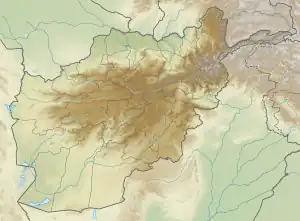| Nuristan National Park | |
|---|---|
 Nuristan Province in winter | |
 Nuristan National Park | |
| Location | Nuristan Province, Afghanistan |
| Coordinates | 35°12′N 70°42′E / 35.2°N 70.7°E |
| Area | 5,733.07 km2 (2,213.55 sq mi) |
| Established | 5 June 2020 |
| Governing body | Ministry of Agrictulture, Livestock and Irrigation (MAIL) and Communities |
Nuristan National Park is a national park in Afghanistan announced by the Government of Afghanistan on 5 June 2020 (coinciding with World Environment Day), making it the third in the country after Band-e Amir National Park and Wakhan National Park.[2] The Park comprises the entire mountainous eastern Province of Nuristan, which borders Pakistan.[3] According to the FAO, a detailed management plan - and "gazettement" - is still forthcoming.[2]
History
An initial proposal was drafted in 1981, with Nuristan National Park to be formed in what was then Laghman Province and Kunar Province (Nuristan Province was not created, by carving out areas of these two provinces, until July 1988[4]); the report highlighted what were then the "largely undisturbed monsoon-influenced forests", as well as the assemblage of species living therein, including the leopard, snow leopard, Himalayan black bear, and markhor, combined with the traditional way of life of the local communities.[2][5] Although a 2003 UNEP report suggested that 52% of forest cover in Nuristan, Laghman, and Nangahar Provinces was lost between 1977 and 2002, and the National Environmental Protection Agency warned a decade later of continuing illegal logging, a 2008 Wildlife Conservation Society report confirmed the continuing presence of the bear and leopard cat, alongside the grey wolf, golden jackal, yellow-throated marten, and crested porcupine, with of a number of other felids reported by interviewees.[2][6][7] The area also includes part of the Pech and Waygal valleys Important Bird Area, with at least fifty-three breeding species of bird.[2][8]

See also
References
- ↑ Nuristan Protected Planet
- 1 2 3 4 5 "Combating land degradation and biodiversity loss by promoting sustainable rangeland management and biodiversity conservation in Afghanistan" (PDF). FAO. Retrieved 14 August 2021.
- ↑ Federal Office for Immigration and Asylum, Austria, ed. (17 December 2020). "Afghanistan Country Report Security Situation". p. 148.
- ↑ Ayalon, Ami, ed. (1990). Middle East Contemporary Survey, Volume XII, 1988. Westview Press. p. 124. ISBN 9780429718984.
- ↑ Sayer, J. A.; Van der Zon, A. P. M. (1981), National Parks and Wildlife Conservation, Afghanistan: a Contribution to a Conservation Strategy, Rome: FAO
- ↑ National Environmental Protection Agency of the Islamic Republic of Afghanistan (ed.). "National Biodiversity Strategy & Action Plan: Framework for Implementation 2014–2017" (PDF). Retrieved 14 August 2021.
- ↑ Karlstetter, Maria (August 2008). "Wildlife Surveys and wildlife conservation in Nuristan, Afghanistan: including Scat and Small Rodent Collection from Other Sites". Wildlife Conservation Society. Retrieved 14 August 2021.
- ↑ "Pech and Waygal valleys". BirdLife International. Retrieved 15 August 2021.
